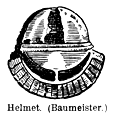Galea
(
κράνος, poet.
κόρυς,
πήληξ). A helmet, casque. The helmet was originally made of skin or leather, whence
is supposed to have arisen its appellation,
κυνέη, meaning
properly a helmet of dogskin, but applied to caps or helmets made of the hide of other
animals, not necessarily worn as armour (
ταυρείη, κτιδέη,
Hom. Il. x. 258, 335;
αἰγείη,
Homer Od. xxiv. 230;
Herod.vii. 77;
galea lupina, Propert. iv. 11,
19), and even to those which were entirely of bronze or iron (
Od. xviii. 377). The leathern basis of the helmet was also very
commonly strengthened and adorned by the addition of either bronze or gold (
Il. xi. 352). Helmets which had a metallic basis were in Latin properly
called
cassides (
Tac. Germ.
6), although the terms
galea and
cassis are
often confounded. A casque (
cassis) found at Pompeii is preserved in the
collection at Goodrich Court in England. The perforations for
 |
|
Helmets. (From the collection at Goodrich Court.)
|
the lining and exterior border are visible along its edge. Among the materials used
for the lining of helmets were felt (
πῖλος,
Il. x. 265) and sponge (Aristot.
H. A. v. 16).
The helmet, especially that of skin or leather, was sometimes a mere cap conformed to the
shape of the head, without either crest or any other ornament. In this state it was probably
used in hunting (
galea venatoria, C. Nep.
Dat. iii. 2), and was called
καταῖτυξ,
in Latin
cudo. The preceding illustration shows an example of it as worn
by Diomede in a small Greek bronze, which is also in the collection at Goodrich Court. The
additions by which the external appearance of the helmet was varied, and which served both for
ornament and protection, were the following:
1.
The
φάλος, which was either single, double (
ἀμφίφαλος, δίφαλος), or quadruple (
τετράφαλος). It has been held that the
φάλος
was the projecting peak of the helmet. According to this view,
τετράφαλος is admittedly unintelligible, and it is certain that the
φάλος was a ridge of metal, afterwards called
κῶνος (Buttmann), which served as a support for the crest. Instances
occur where there are two or more such ridges. In the illustration below, from a gem with the
head of Athené Parthenos, the
φάλοι are
represented by
 |
|
Helmets. (From gems.)
|
a Sphinx and two Pegasi.
2.
The helmet thus adorned was very commonly surmounted by the crest (
crista,
λόφος), which was often of horse-hair
(
ἵππουρις, ἱπποδάσεια,
hirsuta
iuba, Propert. iv. 11, 19), and made so as to look imposing and terrible. The helmet
often had two or even three crests (cf. the illustration above with the head of
Athené, having a helmet with a triple crest). In the Roman army of later times the
crest served not only for ornament, but also to distinguish the centurions (Veget. ii. 13).
The annexed illustration from
 |
|
Helmet. (Baumeister.)
|
a part of a centurion's tomb, from Petronell, shows the transverse crest.
3.
The two cheekpieces (
bucculae,
παραγναθίδες), which were usually attached to the helmet by hinges, so as to be
lifted up and down. They had buttons or ties at their extremities for fastening the helmet on
the head. A strap passed under the wearer's chin, in the case of the Homeric helmet (
Il. iii. 371), but apparently cheek-pieces were not movable.
4.
The beaver, or visor, a peculiar form of which is supposed to have been the
αὐλῶπις τρυφάλεια—i. e. the perforated beaver (
Hom. Il. xi. 353). The gladiators wore helmets
somewhat of this kind (
Juv.viii. 203), and specimens of them, not
unlike those worn in the Middle Ages, have been found at Pompeii. See the illustration to
Gladiatores.







